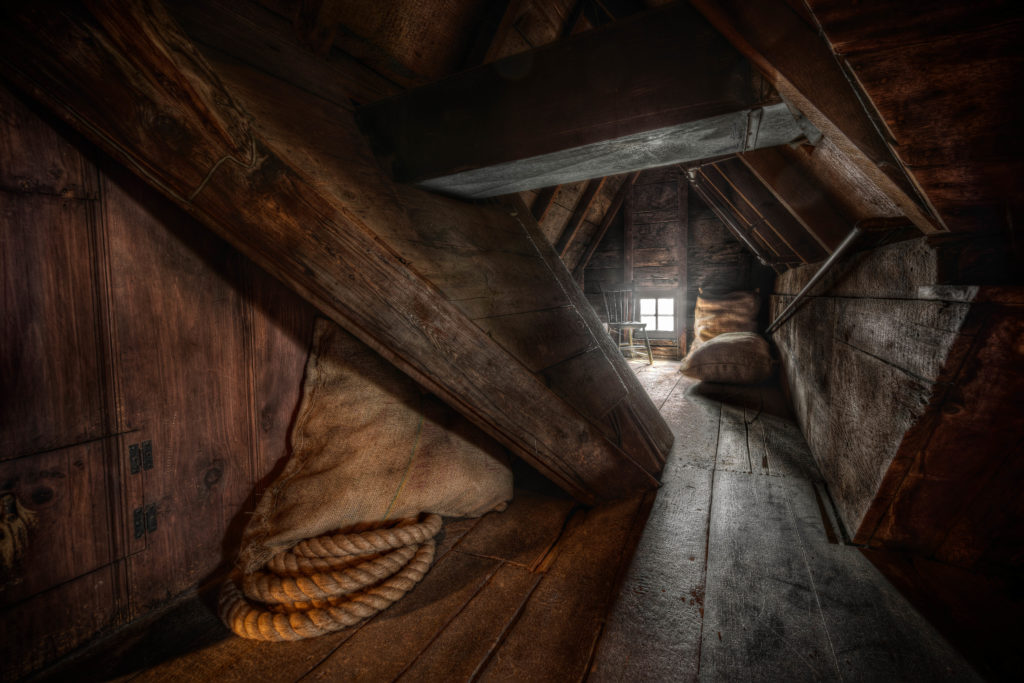
Excerpt from Chapter 14 of
The House of the Seven Gables
by Nathaniel Hawthorne
Photos by Frank C. Grace
First published in 1851, The House of the Seven Gables is the tale of a cursed house with a “mysterious and terrible past” and the generations linked to it— in Mary Oliver’s words, “lives caught in the common fire of history.”
By this time, the sun had gone down, and was tinting the clouds towards the zenith with those bright hues which are not seen there until sometime after sunset, and when the horizon has quite lost its richer brilliancy. The moon, too, which had long been climbing overhead, and unobtrusively melting its disk into the azure—like an ambitious demagogue, who hides his aspiring purpose by assuming the prevalent hue of popular sentiment—now began to shine out, broad and oval, in its middle pathway. These silvery beams were already powerful enough to change the character of the lingering daylight. They softened and embellished the aspect of the old house; although the shadows fell deeper into the angles of its many gables, and lay brooding under the projecting story, and within the half-open door. With the lapse of every moment, the garden grew more picturesque; the fruit-trees, shrubbery, and flower-bushes had a dark obscurity among them. The common-place characteristics—which, at noontide, it seemed to have taken a century of sordid life to accumulate—were now transfigured by a charm of romance. A hundred mysterious years were whispering among the leaves, whenever the slight sea-breeze found its way thither and stirred them. Through the foliage that roofed the little summer house the moonlight flickered to and fro, and fell silvery white on the dark floor, the table, and the circular bench, with a continual shift and play, according as the chinks and wayward crevices among the twigs admitted or shut out the glimmer.
So sweetly cool was the atmosphere, after all the feverish day, that the summer eve might be fancied as sprinkling dews and liquid moonlight, with a dash of icy temper in them, out of a silver vase. Here and there a few drops of this freshness were scattered on a human heart, and gave it youth again, and sympathy with the eternal youth of nature. The artist chanced to be one on whom the reviving influence fell. It made him feel—what he sometimes almost forgot, thrust so early as he had been into the rude struggle of man with man–how youthful he still was.

“It seems to me,” he observed, “that I never watched the coming of so beautiful an eve, and never felt anything so very much like happiness as at this moment. After all, what a good world we live in! How good, and beautiful! How young it is, too, with nothing really rotten or age-worn in it! This old house, for example, which sometimes has positively oppressed my breath with its smell of decaying timber! And this garden, where the black mould always clings to my spade, as if I were a sexton, delving in a grave-yard! Could I keep the feeling that now possesses me, the garden would every day be virgin soil, with the earth’s first freshness in the flavor of its beans and squashes; and the house!—it would be like a bower in Eden, blossoming with the earliest roses that God ever made. Moonlight, and the sentiment in man’s heart responsive to it, are the greatest of renovators and reformers. And all other reform and renovation, I suppose, will prove to be no better than moonshine!”

Photos by Frank C. Grace
of the actual House of the Seven Gables in Salem, Massachusetts.
Frank turns renowned locations into stylized, yet creepy, works of art. Frank has been photographing weird and wonderful New England for the last 13 years. He combines his camera and eye with Photoshop manipulation to bring out the surreal aspects of his subjects. He’s been a finalist for Ron Howard’s “Project Imagin8ion” for two consecutive years, his work has been shown in galleries in both New England and New York, his photography is featured in the stage show An Evening of Ghost Stories and New England Legends, and he loves all things ghostly and haunted.
I would say my most favorite subjects either have some historic significance, are abandoned, reportedly haunted, or even better when all three are combined! I like to see my camera as the closest I will get to having a time machine when I go to historic locations. I tend to take a lot of long exposures so when I am in these types of locations, I can really take in my surroundings as I wait for the shutter to close. Every time I go out with my camera is a learning experience. I always try something new or learn something new due to the subject I am capturing or environmental conditions at the scene. In reality, I truly like to capture anything that I find interesting whether it be people, places or things. I am always craving to shoot somewhere new. Photography is definitely more of an obsession than a simple hobby. I have been published in several books, magazines and local newspapers as well as show prints in local art galleries in Southeastern Massachusetts.
For the majority of my gritty high dynamic range (HDR) or tone mapping, I typically shoot in aperture priority and bracket for exposures between +4 and -4 EV. I use either Photoshop’s HDR or HDR Soft’s Photomatix Pro along with a host of plugins to get the desired effects. I have recently switched from a Sony D850 DLSR or the mirrorless Sony A7RIV for a camera.
Frank lives in Acushnet, Massachusetts with his wife of 29 years and their twin boys, and their dog, Zoe.



